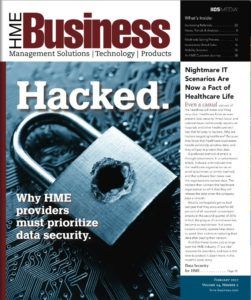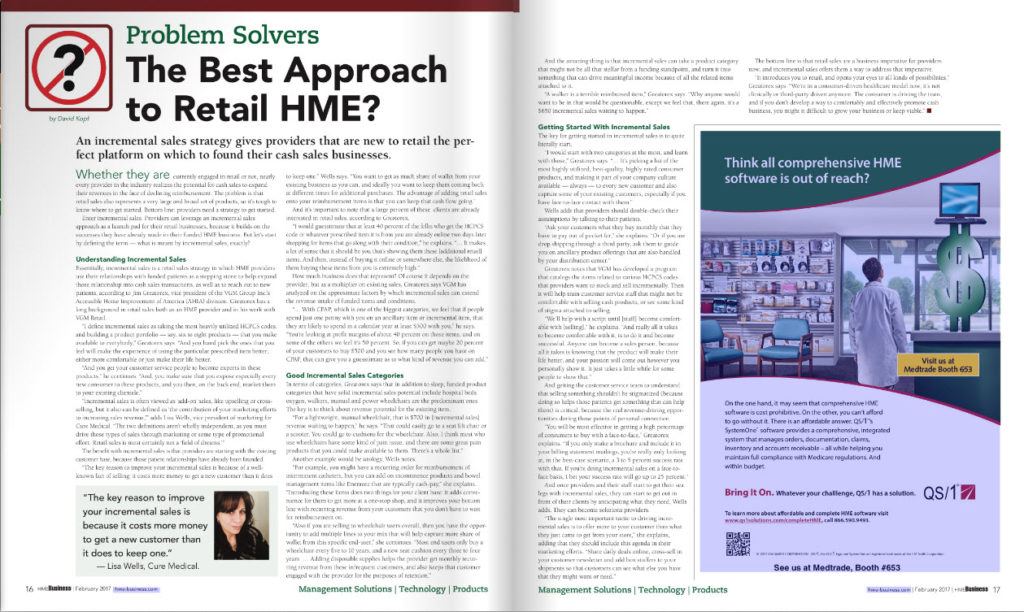For HME/DME Providers: As seen in the February 2017 issue of HME Business Magazine
 An incremental sales strategy gives providers that are new to retail the perfect platform on which to found their cash sales businesses.
An incremental sales strategy gives providers that are new to retail the perfect platform on which to found their cash sales businesses.
Whether they are currently engaged in retail or not, nearly every provider in the industry realizes the potential for cash sales to expand their revenues in the face of declining reimbursement. The problem is that retail sales also represents a very large and broad set of products, so it’s tough to know where to get started. Bottom line: providers need a strategy to get started. Enter incremental sales. Providers can leverage an incremental sales approach as a launch pad for their retail businesses, because it builds on the successes they have already made in their funded HME business. But let’s start by defining the term — what is meant by incremental sales, exactly?
Understanding Incremental Sales
Essentially, incremental sales is a retail sales strategy in which HME providers use their relationships with funded patients as a stepping stone to help expand those relationship into cash sales transactions, as well as to reach out to new patients, according to Jim Greatorex, vice president of the VGM Group Inc.’s Accessible Home Improvement of America (AHIA) division. Greatorex has a long background in retail sales both as an HME provider and in his work with VGM Retail.

As seen in Feb 2017 HME Business Magazine
“I define incremental sales as taking the most heavily utilized HCPCS codes, and building a product portfolio — say, six to eight products — that you make available to everybody,” Greatorex says. “And you hand pick the ones that you feel will make the experience of using the particular prescribed item better; either more comfortable or just make their life better. “And you get your customer service people to become experts in these products,” he continues. “And, you make sure that you expose especially every new consumer to these products, and you then, on the back end, market them to your existing clientele.”
“Incremental sales is often viewed as ‘add-on’ sales, like upselling or crossselling, but it also can be defined as ‘the contribution of your marketing efforts to increasing sales revenue.’”
“The two definitions aren’t wholly independent, as you must drive those types of sales through marketing or some type of promotional effort. Retail sales is most certainly not a ‘field of dreams.’” The benefit with incremental sales is that providers are starting with the existing customer base, because those patient relationships have already been founded.
“The key reason to improve your incremental sales is because of a well-known fact of selling: it costs more money to get a new customer than it does to keep one.” “You want to get as much share of wallet from your existing business as you can, and ideally you want to keep them coming back at different times for additional purchases. The advantage of adding retail sales onto your reimbursement items is that you can keep that cash flow going.”
And it’s important to note that a large percent of these clients are already interested in retail sales, according to Greatorex. “I would guesstimate that at least 40 percent of the folks who get the HCPCS code or whatever prescribed item it is from you are already online two days later shopping for items that go along with their condition,” he explains.
“It makes a lot of sense that it should be you that’s showing them these [additional retail] items. And then, instead of buying it online or somewhere else, the likelihood of them buying these items from you is extremely high.”
How much business does that represent? Of course it depends on the provider, but as a multiplier on existing sales, Greatorex says VGM has analyzed on the approximate factors by which incremental sales can extend the revenue intake of funded items and conditions.
“With CPAP, which is one of the biggest categories, we feel that if people spend just one penny with you on an ancillary item or incremental item, that they are likely to spend in a calendar year at least $500 with you,” he says. “You’re looking at profit margins of about 40 percent on those items, and on some of the others we feel it’s 50 percent. So, if you can get maybe 20 percent of your customers to buy $500 and you see how many people you have on CPAP, that can give you a guesstimate as to what kind of revenue you can add.”

Remember, it may be easier for your customers to shop online rather than in-store. Give them options!
Good Incremental Sales Categories
In terms of categories, Greatorex says that in addition to sleep, funded product categories that have solid incremental sales potential include hospital beds, oxygen, walkers, manual and power wheelchairs are the predominant ones. The key is to think about revenue potential for the existing item.
“For a lightweight, manual wheelchair, that is $700 in [incremental sales] revenue waiting to happen,” he says. “That could easily go to a seat lift chair or a scooter. You could go to cushions for the wheelchair. Also, I think most who use wheelchairs have some kind of pain issue, and there are some great pain products that you could make available to them. There’s a whole list.”
Another example would be urology, Wells notes.
“For example, you might have a recurring order for reimbursement of intermittent catheters, but you can add on incontinence products and bowel management items like Enemeez that are typically cash-pay,” she explains.
“Introducing these items does two things for your client base: it adds convenience for them to get more at a one-stop shop, and it improves your bottom line with recurring revenue from your customers that you don’t have to wait for reimbursement on.

“Also if you are selling to wheelchair users overall, then you have the opportunity to add multiple lines to your mix that will help capture more share of wallet from this specific end-user,” she continues. “Most end users only buy a wheelchair every five to 10 years, and a new seat cushion every three to four years. … Adding disposable supplies helps the provider get monthly recurring revenue from these infrequent customers, and also keeps that customer engaged with the provider for the purposes of retention.”
And the amazing thing is that incremental sales can take a product category that might not be all that stellar from a funding standpoint, and turn it into something that can drive meaningful income because of all the related items attached to it.
“A walker is a terrible reimbursed item,” Greatorex says. “Why anyone would want to be in that would be questionable, except we feel that, there again, it’s a $650 incremental sales waiting to happen.”

Getting Started With Incremental Sales
The key for getting started in incremental sales is to quite literally start.
“I would start with two categories at the most, and learn with those,” Greatorex says. “… It’s picking a list of the most highly utilized, best-quality, highly rated consumer products, and making it part of your company culture available — always — to every new customer and also capture some of your existing customers, especially if you have face-to-face contact with them.”
Wells adds that providers should double-check their assumptions by talking to their patients. “Ask your customers what they buy monthly that they have to pay out of pocket for,” she explains. “Or if you are drop shipping through a third party, ask them to guide you on ancillary product offerings that are also handled by your distribution center.”
Greatorex notes that VGM has developed a program that catalogs the items related to various HCPCS codes that providers want to stock and sell incrementally. Then it will help train customer service staff that might not be comfortable with selling cash products, or see some kind of stigma attached to selling.
“We’ll help with a script until [staff] become comfortable with [selling],” he explains. “And really all it takes to become comfortable with it, is to do it and become successful. Anyone can become a sales person, because all it takes is knowing that the product will make their life better, and your passion will come out however you personally show it. It just takes a little while for some people to show that.”
And getting the customer service team to understand that selling something shouldn’t be stigmatized (because doing so helps those patients get something that can help them) is critical, because the real revenue-driving opportunities during those points of personal connection.
“You will be most effective in getting a high percentage of consumers to buy with a face-to-face,” Greatorex explains. “If you only make a brochure and include it in your billing statement mailings, you’re really only looking at, in the best-case scenario, a 3 to 5 percent success rate with that. If you’re doing incremental sales on a face-toface basis, I bet your success rate will go up to 25 percent.”

Everyone likes a little something extra in their delivery!
And once providers and their staff start to get their sea legs with incremental sales, they can start to get out in front of their clients by anticipating what they need, Wells adds. They can become solutions providers.
“The single most important tactic to driving incremental sales is to offer more to your customer than what they just came to get from your store,” she explains, adding that they should include this agenda in their marketing efforts.
“Share daily deals online, cross-sell in your customer newsletter and add box stuffers to your shipments so that customers can see what else you have that they might want or need.”
The bottom line is that retail sales are a business imperative for providers now, and incremental sales offers them a way to address that imperative. “It introduces you to retail, and opens your eyes to all kinds of possibilities,” Greatorex says. “We’re in a consumer-driven healthcare model now, it’s not clinically or third-party driven anymore.
The consumer is driving the train, and if you don’t develop a way to comfortably and effectively promote cash business, you might it difficult to grow your business or keep viable.”

HME/DME Providers: Cure Medical is your partner and your manufacturer. We are here to help you succeed! This article is designed for our distribution partners and dealers to assist with their efforts to educate, engage with and support the disability community as well as the medical professionals who assist our customers.

 SUBSCRIBE TO HME BUSINESS MAGAZINE HERE.
SUBSCRIBE TO HME BUSINESS MAGAZINE HERE.
Have a Question about this Story?
Contact us!
Our distribution partner team is happy to assist you.
Thank you for Choosing a Cure!
You may also enjoy:



